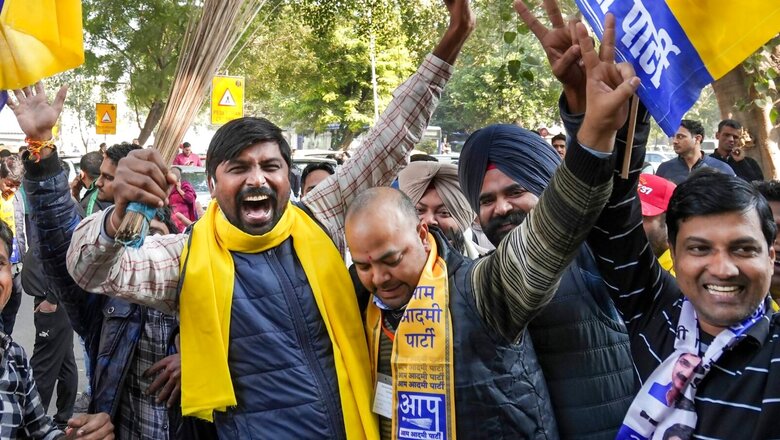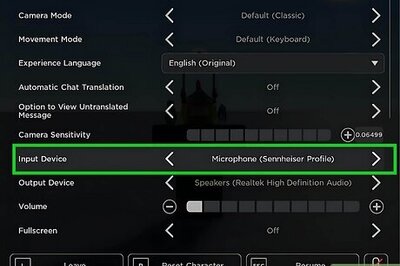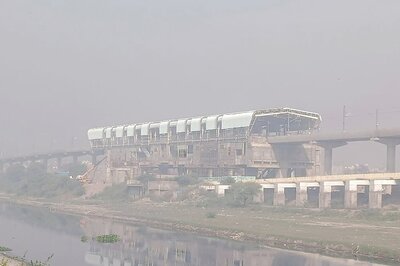
views
With 134 of the total 250 seats in its hold, Arvind Kejriwal-led Aam Aadmi Party (AAP) swept the 2022 Municipal Corporation of Delhi (MCD) election on Wednesday, ending the 15-year-long reign of BJP, which secured 104 seats. The AAP will now have a larger control in the state and civic administration of the city.
This was the first election after the MCD was reunified earlier this year. The exit polls on December 5 had predicted clean sweep for AAP, a distant second for BJP, which had held the position for three consecutive terms since 2007, while the Congress was expected to secure a handful of seats.
Let’s us look at the five factors that largely worked for AAP in the MCD polls in its second attempt at it:
Kejriwal’s ‘Aap ka Vidhyak, Aap ka Parshad’ Campaign
The AAP’s campaign launched just two weeks before the election struck a chord with people, who have been complaining of poor civic amenities such as garbage, sanitation, poor roads, potholes. The cash-strapped MCD has not been able to deliver much, especially, after the Covid-19 pandemic, but the three corporations — North, South and East — were unified into one in the middle of the year for better management.
The BJP-ruled corporations have been blaming the AAP-led Delhi government for not releasing funds as the civic body had crippled its functioning while the latter alleged widespread corruption by the BJP leading to shortage of funds.
The slogan – ‘Aap ka Vidhyak, Aap ka Parshad’ –, which was launched by national AAP convenor and Delhi chief minister Arvind Kejriwal along with his deputy Manish Sisodia resonated among the voters, most of whom are from middle and lower-middle classes besides slums. A senior party leader, who didn’t wish to be named, said, “It gave people hope of better facilities on lines of the party’s work in education, health, cheaper electricity and water bills, among others.”
En Masse Shift of Congress Voters to AAP
Till the last municipal election in 2017, the Congress had held traditional seats in Muslim-majority areas and slum clusters, but its influence began waning since. This time too, AAP has eaten into Congress’ votes.
Congress’ campaign was hardly visible on ground and absence of influential leaders did not bring any weight to the election.
In March 2021, AAP won four out of the five MCD seats in bypolls, one went to the Congress, and BJP did not secure any. It was mainly after the northeast Delhi riots that a section of people in the area voted for the Congress, but it has since not been able to gain from there; instead, its voters have more or less gone to the other political alternative — the AAP. In the five wards that went for bypolls, AAP’s vote share was 46.10%; the BJP’s was 27.29%; and the Congress’s 21.84%.
Lack of Leadership in Delhi BJP
Since the MCD bypolls last year, it is being learnt that the BJP is planning to change its Delhi chief Adesh Gupta as the party has won no big or small election in the city under his leadership. If the BJP fails to make a mark this time, it is certainly going to see a change in the state unit leadership.
The party has been suffering from lack of leadership or prominent faces to lead it through. Also, constant rift among party members is another reason that the BJP first needs to get its own house in order.
This also worked well for the AAP, which, had made a concentrated effort and put a strategy in place to woo voters.
Garbage Mounts as Major Poll Issue
While the AAP had launched an aggressive campaign against the BJP-ruled corporations for its failure to clear the trash mountains in Delhi — the three sanitary landfill sites at Gazipur, Bhalaswa and Okhla — for long, turning it into a poll issue worked well for the party. The issue of waste management and garbage piling up at roadsides along with continuous fires at landfills had been plaguing residents for years. When the AAP promised scientific action based on research to handles city’s problem of waste management, people, tired of dealing with the issue for decades, believed them and again, found hope in its vision.
AAP Built Its Cadre Base
When the BJP won the 2017 civic polls, AAP was setting its ground being a new party, which had won the Delhi assembly. AAP’s expansion to local governance was not seen viable as people were still testing the government.
In 2017, too, there was a strong anti-incumbency wave against the BJP, which had ruled the civic body for a decade, yet Congress was not that strong as an opponent and while AAP was a newbie. The BJP, in an attempt of an image makeover, gave tickets only to fresh faces while none of its sitting councillors were given the chance to contest.
The trick worked and people again voted for it. This has changed now, with AAP making inroads into the middle and lower-middle classes and even in rural areas, which were the only seats that saw the heaviest voter turnout during the voting day on December 4.
Read all the Latest News here


















Comments
0 comment